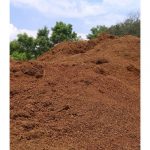
Flash Dryer Manufacturer India
We are the leading flash dryer manufacturer in India. Flash Dryer Machine is used to decrease the moisture content of the granulated agricultural or forest waste. The dried material can be used for making Briquettes and Pellets or for other heating purposes.
Flash dryer are of two types:
Single pass: It can intake the moisture content Upto 25% and decrease it to 10%.
Double pass: It can intake the moisture content upto 40% and decrease it to 10%
Input Raw material: Sawdust, Paddy straw, Coirpith, Bagasse etc






FAQs
A flash dryer is a type of industrial dryer used to rapidly dry and disperse a wide range of materials. The process involves feeding the material into a heated chamber where it is exposed to high-velocity hot air or gas, which quickly evaporates moisture from the material. The dried material is then separated from the exhaust gas stream using a cyclone separator or baghouse filter.
Flash dryers are commonly used in industries where drying is required for materials that are heat-sensitive, delicate, or prone to agglomeration. Here are some examples of industries that use flash dryers:
Chemicals: Flash dryers are used to dry a variety of chemicals, such as pigments, dyes, and polymers.
Pharmaceuticals: These dryers are used to dry and granulate pharmaceutical powders, such as antibiotics and vitamins.
Food: Flash dryers are used to dry food products, such as starches, sugars, and spices.
Minerals: These dryers are used to dry minerals, such as silica, alumina, and limestone.
Waste treatment: Flash dryers are used to dry and process sludge, biosolids, and other organic waste materials.
Some benefits of flash dryers include their ability to dry materials quickly and efficiently, their flexibility to handle a wide range of materials, and their ability to produce uniform and consistent products. Additionally, flash dryers can be designed to meet specific processing requirements, such as controlling the temperature, humidity, and velocity of the drying gas, which can further improve product quality and consistency.
Flash dryers are used in various industries and applications where rapid and efficient drying is required. Some common uses of flash dryers are:
Chemical industry: Flash dryers are used to dry heat-sensitive chemicals, such as pigments, dyes, and polymers.
Pharmaceutical industry: Flash dryers are used to dry and granulate pharmaceutical powders, such as antibiotics and vitamins.
Food industry: Flash dryers are used to dry food products, such as starches, sugars, and spices.
Mineral industry: Flash dryers are used to dry minerals, such as silica, alumina, and limestone.
Waste treatment: Flash dryers are used to dry and process sludge, biosolids, and other organic waste materials.
Agricultural industry: Flash dryers are used to dry agricultural products, such as grains, soybeans, and animal feeds.
Textile industry: Flash dryers are used to dry textiles, such as cotton, wool, and synthetic fibers.
Some of the benefits of flash dryers include their ability to dry materials quickly and efficiently, their flexibility to handle a wide range of materials, and their ability to produce uniform and consistent products. Additionally, flash dryers can be designed to meet specific processing requirements, such as controlling the temperature, humidity, and velocity of the drying gas, which can further improve product quality and consistency.
Flash drying is a drying technology that involves rapid drying of materials using a stream of hot gas, typically air. The process involves feeding wet material into a chamber, where it is dispersed into a stream of hot gas, which quickly evaporates the moisture from the material. The dried material is then separated from the gas and collected.
Flash drying is widely used in industries such as food processing, chemical processing, pharmaceuticals, and mineral processing, where materials need to be dried quickly and efficiently. The advantages of flash drying include high drying rates, short residence times, and low capital and operating costs compared to other drying technologies.
The flash drying process can be customized to suit specific materials and applications. For example, the inlet temperature of the hot gas can be adjusted to control the drying rate, and the size and configuration of the drying chamber can be optimized to achieve the desired drying performance.
There are various types of flash dryers, including pneumatic, rotary, and fluidized bed dryers. Each type of dryer has its own advantages and limitations, and the selection of the appropriate type of dryer depends on factors such as the properties of the material being dried, the required drying rate, and the desired end product.
Overall, flash drying is a highly efficient and cost-effective drying technology that is widely used in many industries. It is a versatile process that can be tailored to suit specific materials and applications, making it a popular choice for a wide range of drying needs.
Flash dryers offer several benefits compared to other types of dryers. Here are some of the main benefits of using flash dryers:
Fast and efficient drying: Flash dryers can dry materials quickly and efficiently, which can save time and energy compared to other types of dryers.
Versatile: Flash dryers can be used to dry a wide range of materials, including heat-sensitive materials that cannot be dried using other types of dryers.
Uniform product quality: Flash dryers can produce uniform and consistent products, which can improve product quality and reduce waste.
Compact design: Flash dryers have a compact design, which can save space and make them easier to install and operate.
Low maintenance: Flash dryers have a simple design and require minimal maintenance, which can reduce operating costs.
Environmentally friendly: Flash dryers use hot air or gas as the drying medium, which can reduce the need for fossil fuels and lower greenhouse gas emissions.
Overall, the benefits of flash dryers make them a popular choice for many industries that require fast and efficient drying of materials.
There are several types of flash dryers, each designed to meet specific processing requirements. Here are some of the main types of flash dryers:
Conventional Flash Dryers: Conventional flash dryers use a combination of hot air and product particles to achieve rapid drying. The product is fed into the dryer through a feed hopper and is then pneumatically conveyed through the dryer using a high-velocity air stream.
Agitated Flash Dryers: Agitated flash dryers use a mechanical agitator to break up and disperse the wet material, which can help to improve drying efficiency and reduce clumping.
Fluidized Bed Flash Dryers: Fluidized bed flash dryers use a bed of hot gas or air to suspend and fluidize the wet material, which can help to improve drying efficiency and reduce material degradation.
Spin Flash Dryers: Spin flash dryers use a spinning disc to atomize the wet material and create a fine mist, which is then dried using a high-velocity hot air stream.
Vacuum Flash Dryers: Vacuum flash dryers use low pressure and temperature to evaporate the moisture from the wet material, which can help to reduce heat damage and improve product quality.
Each type of flash dryer has its own advantages and disadvantages, and the choice of dryer will depend on the specific processing requirements and characteristics of the material being dried.
